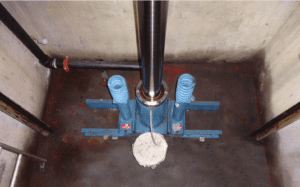
Currently, I have heard a lot of debate about whether an elevator pit fire sprinkler will have to be installed the bottom of an elevator pit to a traction elevator? We have a sprinkler in the elevator pit of a traction elevator, and the AHJ says that fire sprinkler can be removed and is not needed per NFPA -13 – 8.15.5.2. The AHJ indicated that if the fire sprinkler was to remain in its current location that it would have to have dedicated monitoring and shunt the elevator or that we can remove the said fire sprinkler. Either way would be acceptable to the local AHJ, and they did not seem to have a preference.

The second debate is where I am reaching out for further opinion. It seems very cut in dry that per 2013 NFPA – 8.15.5.2 that the sprinklers not required. This debate is whether the elevator inspector will enforce the sprinkler in the elevator pit? ASME A17.1 – 2004 Safety Code for Elevators and Escalators seems only to tell you what to do if there is a fire sprinkler in the elevator pit. Honestly, I have not read the whole thing and do not have a searchable copy.
Who has jurisdiction over the sprinkler in the elevator pit? The local AHJ or the State Elevator Inspector?
During my investigation to determine whether to remove or leave the sprinkler. I also ran across an article from William E Koffel, P.E about Sprinklers in Elevator Hoistways and Machine Rooms. This article is old since it references NFPA 13, 1989, but does bring up a relevant subject and that is the fact that it talks about the buildup of trash and debris that has collected at the bottom of the shaft. That over time will provide a potential fire load at the bottom of the elevator pit. Has anyone seen this article roaming the internet, but more importantly is the State Elevator Inspector in forcing a sprinkler to be installed because of the potential for the buildup of refuse in the bottom of the elevator pit because of the scenario presented in this article.
A Circular Letter E-99-1 – Shunt Trips for Sprinkler in Elevator Pits was presented to me to substantiate leaving the sprinkler and not having to shunt the elevator. This Circular is from the State of California Department of Industrial Relations and seems to indicate that they will not require the shunt trip on the sprinklers located two feet or less from the elevator pit floor. When I approached the city AHJ about this circular letter, he indicated that he was aware of it and that if the fire sprinkler was to remain that it would have to be monitored and shunt the elevator.
I was hoping that someone with a passion for the NFPA 13, ASME 17.1 and California Building Code can help myself and other individuals in similar occupations make a little more sense of who has jurisdiction over the elevator pit and if a fire sprinkler should be required in a California elevator pit.
To learn more about the requirements of fire sprinklers in elevator pits and access NFPA 13.
To learn more about the buyer requirements of fire sprinklers in elevator pits and access NFPA 13.
To check the closing pressure on elevator doors purchase one of our door pressure gauges.

Knee clearance is one of those little design details that makes a big difference in how comfortable and accessible public space feels. In places like

Learn the steps to obtain ADA inspector certification for your business, ensuring compliance with accessibility standards and enhancing your services for all clients
Currently, I have heard a lot of debate about whether an elevator pit fire sprinkler will have to be installed the bottom of an elevator pit to a traction elevator? We have a sprinkler in the elevator pit of a traction elevator, and the AHJ says that fire sprinkler can be removed and is not needed per NFPA -13 – 8.15.5.2. The AHJ indicated that if the fire sprinkler was to remain in its current location that it would have to have dedicated monitoring and shunt the elevator or that we can remove the said fire sprinkler. Either way would be acceptable to the local AHJ, and they did not seem to have a preference.

The second debate is where I am reaching out for further opinion. It seems very cut in dry that per 2013 NFPA – 8.15.5.2 that the sprinklers not required. This debate is whether the elevator inspector will enforce the sprinkler in the elevator pit? ASME A17.1 – 2004 Safety Code for Elevators and Escalators seems only to tell you what to do if there is a fire sprinkler in the elevator pit. Honestly, I have not read the whole thing and do not have a searchable copy.
Who has jurisdiction over the sprinkler in the elevator pit? The local AHJ or the State Elevator Inspector?
During my investigation to determine whether to remove or leave the sprinkler. I also ran across an article from William E Koffel, P.E about Sprinklers in Elevator Hoistways and Machine Rooms. This article is old since it references NFPA 13, 1989, but does bring up a relevant subject and that is the fact that it talks about the buildup of trash and debris that has collected at the bottom of the shaft. That over time will provide a potential fire load at the bottom of the elevator pit. Has anyone seen this article roaming the internet, but more importantly is the State Elevator Inspector in forcing a sprinkler to be installed because of the potential for the buildup of refuse in the bottom of the elevator pit because of the scenario presented in this article.
A Circular Letter E-99-1 – Shunt Trips for Sprinkler in Elevator Pits was presented to me to substantiate leaving the sprinkler and not having to shunt the elevator. This Circular is from the State of California Department of Industrial Relations and seems to indicate that they will not require the shunt trip on the sprinklers located two feet or less from the elevator pit floor. When I approached the city AHJ about this circular letter, he indicated that he was aware of it and that if the fire sprinkler was to remain that it would have to be monitored and shunt the elevator.
I was hoping that someone with a passion for the NFPA 13, ASME 17.1 and California Building Code can help myself and other individuals in similar occupations make a little more sense of who has jurisdiction over the elevator pit and if a fire sprinkler should be required in a California elevator pit.
To learn more about the requirements of fire sprinklers in elevator pits and access NFPA 13.
To learn more about the buyer requirements of fire sprinklers in elevator pits and access NFPA 13.
To check the closing pressure on elevator doors purchase one of our door pressure gauges.